

Making![]() generalizations about the visual
culture of any group of people is a crude endeavor, especially
with a culture as diverse as Poland's. With this thought in mind,
know that this survey, as any must be, is tremendously limited
in its breadth and depth.
generalizations about the visual
culture of any group of people is a crude endeavor, especially
with a culture as diverse as Poland's. With this thought in mind,
know that this survey, as any must be, is tremendously limited
in its breadth and depth.
[Expect a more in-depth article to appear here soon.]
Examples of Polish art:
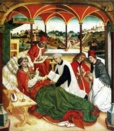
Jan Polack (Polish, -1519), The Death of St. Corbinian, 1484-85,
oil on wood
panel, 147 x 129 cm, Alte Pinakothek,
Munich. Northern Renaissance painter.

Piotr Michalowski (Polish, 1800-1855), Cavalier on a Horse (Kawalerzysta na koniu),
oil on canvas,
61 x 46 cm, collection of Ewa and Wojciech Fibak. An adherent
of Romanticism,
Michalowski has been called "the Polish Gericault,"
a painter of portraits,
equine subjects, and battle
scenes.

Piotr Michalowski, Battle of Samosierra (Bitwa pod Samosierrà),
National Museum, Cracow.

Piotr Michalowski, Portrait of a peasant with a hat (Portret chlopa
w kapeluszu), oil
on canvas, 52,7 x 35,5
cm, Polish National Museum, Warsaw.
Napoleon Orda (Polish, 1807-1883)

Henryk Rodakowski (Polish, 1823-1894), Portrait of the artist's daughter, Maria Wozniakowska
(Portret córki artysty, Marii Woêniakowskiej),
oil on canvas,
120 x 85 cm, Lvov Painting Gallery.
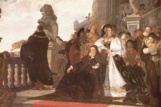
Henryk Rodakowski, Wojna kokosza, 1872, oil
on canvas, Polish National
Museum, Warsaw.
Juliusz Kossak (Polish, 1824-1899). A painter of equine subjects.
Henryk Siemiradzki (Polish, 1834-1902)
Artur Grottger (Polish, 1837-1867). His history and genre scenes represent a more local Polish variation of Romanticism.
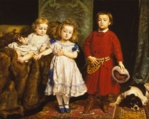
Jan Matejko (Polish, 1838-1893), Portrait of the artist's three children (Portret
trojga dzieci artysty), 1870, oil,
Polish National Museum, Warsaw.
Jozef Brandt (Polish, 1841-1915)
Maksymilian Gierymski (Polish, 1846-1874)
Jozef Chelmonski (Polish, 1849-1914). A painter of landscapes.
Aleksander Gierymski (Polish, 1850-1901). French Impressionism.
Stanislaw Witkiewicz (Polish, 1851-1915)
Leon Wyczolkowski (Polish, 1852-1936). Polish Impressionism and Symbolism.
Julian Falat (Polish, 1853-1929). Polish Impressionism.
Jacek Malczewski (Polish, 1854-1929). See Symbolism and Romanticism.

Wladyslaw Slewinski (Polish, c. 1854 - 1918),
Self-Portrait with Hat (Autoportret w slomkowym
kapeluszu), c. 1894, oil
on canvas, 60 x 45 cm,
Polish National Museum, Warsaw. See self-portrait.

Wladyslaw Slewinski, Bouquet of Roses, c. 1902, oil
on canvas, 55 x 37 cm,
collection of Wladyslawa Jaworska, Warszawa. See still life.

Wladyslaw Slewinski, Stare domy w Kazimierzu nad Wislà ,
c. 1908, oil on canvas,
48.6 x 59.7 cm, collection of A.G.Altschul, NY.
Jan Stanislawski (Polish, 1860-1907)
Olga Bozna_ska (Polish, 1865-1940)
Samuel Hirszenberg (Polish, 1865-1908). See Jewish art.
Józef Pankiewicz (Polish, 1866-1940). Polish Impressionism and Symbolism.
Wladyslaw Podkowi_ski (Polish, 1866-1895). Polish Impressionism and Symbolism.
Ludwik de Laveaux (Polish, 1868-1894)
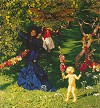
Józef Mehoffer (Polish, 1869-1946),
The Strange Garden, 1903, oil
on canvas, 217 x 208 cm,
Polish National Museum, Warsaw, Poland. Member of Sztuka
(Art), an organization of Polish painters related to Art Nouveau, founded in 1897. Mehoffer
is also noted for his designs for stained glass windows.
Stanislaw Wyspianski (Polish, 1869-1907). Another member of Sztuka.

Ferdynand Ruszczyc (Polish, 1870-1936), Earth,
1898, Polish National Museum, Warsaw.
Konrad Krzy_anowski (Polish, 1872-1922)
Wojciech Weiss (Polish, 1875-1950)
Boleslas Biegas (Polish, 1877-1954), 1902,
Sphinx, sculpture,
bust, Musée d'Orsay, Paris.
See sphinx and Symbolism.
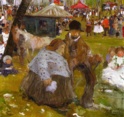
Witold Wojtkiewicz (Polish, 1879-1909), Pentecost Holiday Fair
near Cracow (also called Carrousel), 1906, oil
on canvas, 96 x 100 cm
(37 7/8 x 39 3/8 inches), Detroit Institute of Arts, MI.

Witold Wojtkiewicz, Porwanie królewny (Ucieczka),
1908, tempera, Polish National
Museum, Warsaw.
Tadeusz Makowski (Polish, 1882-1932)

Elie Nadelman (American, born Poland, 1882-1946),
Dancer, c. 1918-1919, cherrywood, The Jewish
Museum, NY. See curvilinear,
Jewish art, movement, sculpture,
and wood.

Stanislaw Ignacy (Witkacy) Witkiewicz (Polish,
1885-1939), Pocalunek mongolskiego ksiecia na lodowej pustyni,
1915-18, Polish National Museum, Warsaw. See Expressionism.

Stanislaw Ignacy (Witkacy) Witkiewicz (Polish,
1885-1939), Self-Portrait,
1927, pastel on paper,
65.0 x 49.0 cm, Museum of Central Pomerania, Slupsk, Poland.
See self-portrait.
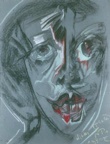
Stanislaw Ignacy (Witkacy) Witkiewicz, Portrait
of Edwardy Szmuglarowskiej, 1930, pastel
on paper, 65.0 x 48.0 cm, Museum of
Central Pomerania, Slupsk, Poland. He is known to have experimented
with the drug peyote in 1928. See portrait.
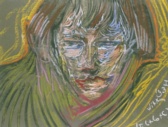
Stanislaw Ignacy (Witkacy) Witkiewicz, Portrait
of Zofii Jagodowskiej, 1930, pastel
on paper, 50.0 x 65.0 cm, Museum of
Central Pomerania, Slupsk, Poland.
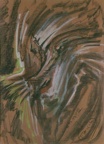
Stanislaw Ignacy (Witkacy) Witkiewicz, Portrait
of Heleny Bialynickiej-Biruli, 1930, pastel
on paper, 66.0 x 49.0 cm, Museum of
Central Pomerania, Slupsk, Poland.
Zygmunt Waliszewski (Polish, 1897-1936)

Tamara de Lempicka (born in Poland; from
the age of 20, active in Paris and America; 1898-1980), Self-Portrait
in the Green Bugatti, 1925, oil
on wood panel,
private collection. See Art
Deco.

Tamara de Lempicka, Spring, 1928, oil
on wood panel,
private collection.

Tamara de Lempicka, Adam and Eve, c. 1932, oil,
Petit Palais, Geneva, Switzerland. See Tamara de Lempicka's studio, c. 1931.

Tamara de Lempicka, Sleeping Woman, 1935, oil
on canvas, private collection.

Tamara de Lempicka, Calla Lilies, 1941, oil,
private collection, CA. See curvilinear.

Magdalena Abakanowicz (Polish, 1930-), Two Figures on a Beam, 1992, burlap,
resin and wood,
Milwaukee Art Museum, WI. See feminist
art.
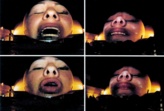
Krzysztof Wodiczko (American, born Poland, 1943-), The Tijuana Projection, 2001, public projection at the Centro Cultural de Tijuana, Mexico (as part of In-Site 2000). Krzysztof Wodiczko creates large-scale slide and video projections of politically-charged images on architectural façades and monuments worldwide. By appropriating public buildings and monuments as backdrops for projections, Wodiczko focuses attention on ways in which architecture and monuments reflect collective memory and history.

![]()

Marek Cecula (American, born Poland, 1944-),
Shard,
1998, authentic porcelain shard,
plaster, wood, glass, 14 x 14 x 2.5 inches, Grand Arts,
Kansas City, MO. Roberta Lord, of Grand Arts wrote, "In
1979, visiting his Polish homeland for the first time in 25 years,
Marek Cecula was strolling with his sister along a Baltic beach
when he spotted a small white object half-buried in the sand.
He picked it up and saw that it was a piece of a ceramic plate
bearing the factory's back stamp, or 'maker's mark.' The mark
in this case was a swastika. Cecula, a self-exiled Polish Jew
who has made ceramics his life's work, and whose father was interned
in Dachau, held in his hand the identifying fragment of a piece
of dinnerware manufactured for the Nazi party. For his 2000 exhibition
Violations, he formed a white plaster 'ghost plate' around
the stamped piece and mounted it in a plain birch box with a
glass face." See hallmark,
Polish art, and shadow
box.
Also see architecture, arms & armor, costume, Dada, degenerate, design, drawing, Dutch art, engraving, etching, expressionism, Expressionism, fascist aesthetic, flags of Europe, French art, furniture, genre, German art, Gothic, history painting, Hungarian art, illumination, Impressionism, jewelry, landscape, lithography, Madonna, marble, Middle Ages, monument, museum, mythology, narrative art, Neoclassicism, Northern Renaissance, nude, pastel, photography, porcelain, portrait, propaganda, Romanticism, Russian art, sculpture, seascape, self-portrait, stained glass, still life, Surrealism, Swiss art, tapestry, tchotchke (czaczko), textile, watercolor, and woodcut, among many other articles.Polish art Polish art
Kolekcja = collection
kredka = chalk, crayon
wegiel = charcoal
Needs:
Translations of titles and other texts in Polish.
Polish names converted to English alphabet correctly?
Any problems with my choices of works to use as examples?
https://inform.quest/_art